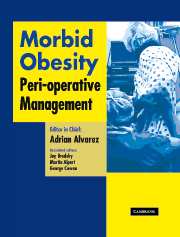Book contents
- Frontmatter
- Contents
- Contributors
- Foreword
- Preface
- Acknowledgments
- Dedication
- Section 1 General aspects
- Section 2 Pathophysiology
- Section 3 Pre-operative management
- Section 4 Peri-operative management of co-morbidities
- 10 Diabetes mellitus
- 11 Co-existing cardiac disease
- 12 Deep venous thrombosis prophylaxis
- 13 Surgical antibiotic prophylaxis
- 14 Renal dysfunction
- Section 5 Pharmacology
- Section 6 Monitoring
- Section 7 Intra-operative management
- Section 8 Post-operative care
- Section 9 Conclusions
- Afterword
- Index
12 - Deep venous thrombosis prophylaxis
from Section 4 - Peri-operative management of co-morbidities
Published online by Cambridge University Press: 17 August 2009
- Frontmatter
- Contents
- Contributors
- Foreword
- Preface
- Acknowledgments
- Dedication
- Section 1 General aspects
- Section 2 Pathophysiology
- Section 3 Pre-operative management
- Section 4 Peri-operative management of co-morbidities
- 10 Diabetes mellitus
- 11 Co-existing cardiac disease
- 12 Deep venous thrombosis prophylaxis
- 13 Surgical antibiotic prophylaxis
- 14 Renal dysfunction
- Section 5 Pharmacology
- Section 6 Monitoring
- Section 7 Intra-operative management
- Section 8 Post-operative care
- Section 9 Conclusions
- Afterword
- Index
Summary
Introduction
The incidence of obesity in the US has increased substantially since the 1960s. More than half of the US adult population is considered overweight (body mass index, BMI > 25 kg/m2).
It is estimated that approximately 300,000 deaths are attributed to obesity each year. Severe obesity ultimately results in a reduced life expectancy and is considered the second most preventable cause of death after cigarette smoking.
Deep venous thrombosis (DVT) affects more than 250,000 patients per year with considerable morbidity and mortality. Without prophylaxis 25% of the general surgery patients would develop DVT with a mortality of up to 17%.
Both DVT and pulmonary embolism (PE) produce few specific symptoms and the first and only manifestation of the disease can be a fatal PE. Therefore, failure to provide adequate venous thromboembolism (VTE) prophylaxis should be avoided at all cost. The use of heparin in surgical patients has decreased the incidence of DVT and PE after surgical procedures.
The addition of mechanical leg compression devices has not proven to enhance this reduction. However, it is common practice to provide both types of DVT protection. In the last few years low-molecular-weight heparin (LMWH) has showed to have better protection for DVT especially in patients considered to be at high risk of developing this entity.
- Type
- Chapter
- Information
- Morbid ObesityPeri-Operative Management, pp. 167 - 172Publisher: Cambridge University PressPrint publication year: 2004

